Clay sculpting can be a powerful tool to soothe anxious minds. Start by choosing a clay that feels comfortable to work with, like air-dry or polymer. Create a calm workspace with natural light and soft music. Begin with simple shapes to build confidence. As you sculpt, practice mindful breathing to enhance focus and relaxation. Express your emotions through figurines, exaggerating features to convey feelings. Embrace imperfections in your work, as they add character and authenticity. Develop a regular sculpting routine to foster creativity and skill development. By incorporating these tips, you'll discover a meditative practice that can help calm your mind and nurture your artistic spirit.
Choose Your Clay Wisely
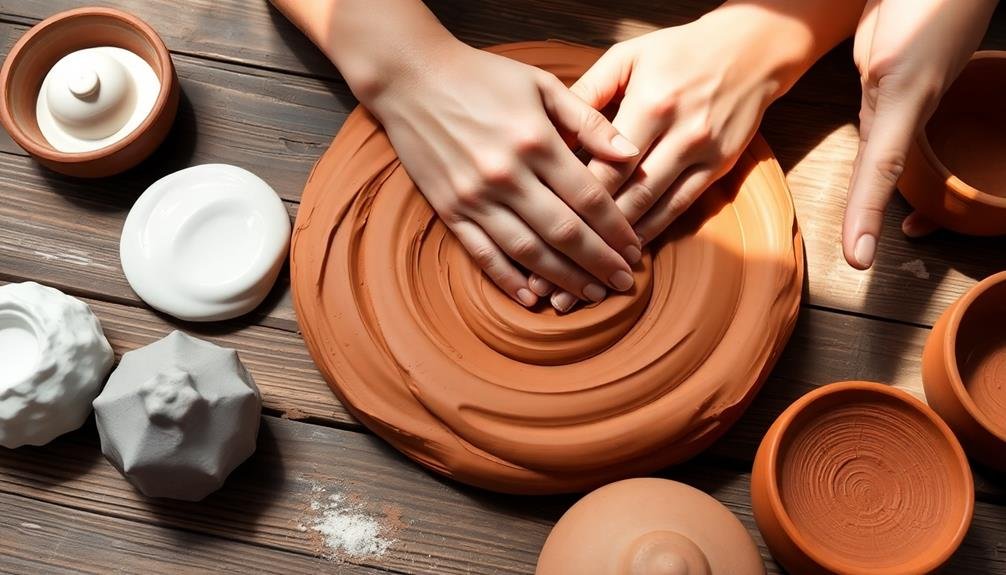
When you're starting your clay sculpting journey, selecting the right clay is essential. Consider your skill level and project goals when choosing between air-dry, polymer, or ceramic clay. Air-dry clay is beginner-friendly and doesn't require baking, making it ideal for simple projects.
Polymer clay offers vibrant colors and durability, perfect for small, detailed creations. Ceramic clay provides a traditional sculpting experience but needs firing in a kiln.
For anxiety relief, opt for softer clays that are easy to manipulate. These allow for a more relaxing, meditative experience. Look for clays with a smooth texture that won't frustrate you with crumbling or sticking.
Avoid clays that dry quickly, as they may cause stress if you're not working fast enough.
Consider the clay's firmness. Softer clays are easier to work with but may not hold intricate details well. Firmer clays offer more control but require more hand strength.
Start with a medium-firm clay and adjust as you gain experience. Remember, the right clay will enhance your sculpting experience and help you achieve a calm, focused state of mind.
Create a Calming Workspace
Now that you've chosen the perfect clay, it's time to set up your workspace. Creating a calming environment is essential for reducing anxiety and fostering creativity.
Start by selecting a quiet area in your home, away from distractions. Make sure you have plenty of natural light or invest in a good desk lamp to avoid eye strain. Choose a comfortable chair that supports your back, as you may spend hours sculpting.
Organize your tools and materials within easy reach, but keep your workspace clutter-free. A clean, organized area can help clear your mind and reduce stress. Consider adding elements that promote relaxation, such as plants or a small fountain. Soft background music or nature sounds can also enhance the calming atmosphere.
To make your sculpting experience even more enjoyable:
- Use a non-stick surface like a silicone mat for easy cleanup
- Keep a spray bottle of water nearby to prevent clay from drying out
- Have reference images or sketches on hand for inspiration
- Set up a timer to remind you to take regular breaks and stretch
Start With Simple Shapes
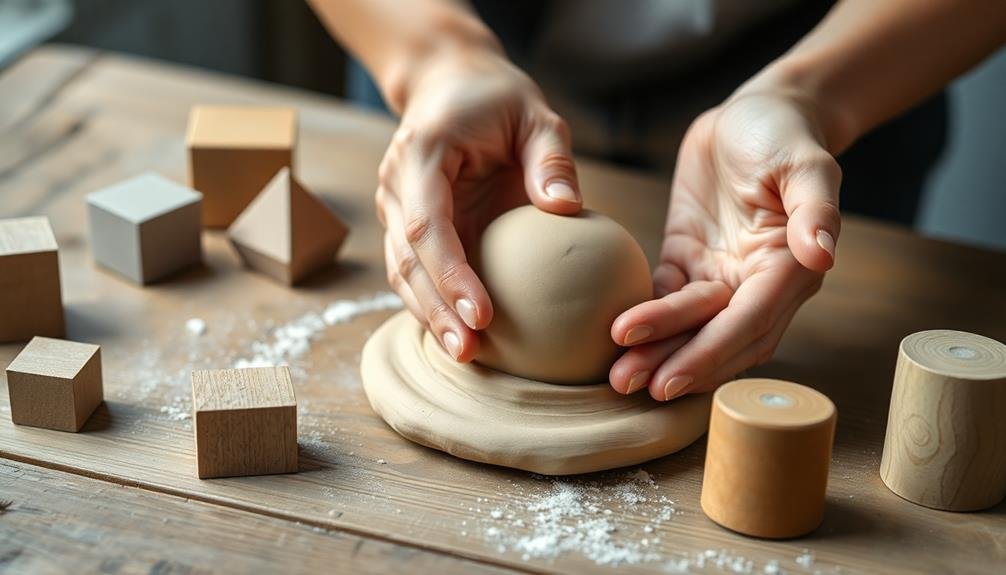
When you're beginning your clay sculpting journey, it's best to start with basic forms.
Focus on mastering spheres, cubes, and cylinders before attempting more complex shapes.
These fundamental shapes will serve as building blocks for your future sculptures, allowing you to develop essential skills and techniques.
Begin With Basic Forms
In order to master clay sculpting, it's essential to start with basic forms. These foundational shapes serve as the building blocks for more complex creations and help you develop vital skills. By focusing on basic forms, you'll gain a better understanding of structure, proportion, and balance in your sculptures.
When beginning your clay sculpting journey, concentrate on creating these fundamental shapes:
- Sphere: Practice molding perfect spheres of various sizes to improve your hand control and symmetry skills.
- Cube: Learn to form sharp edges and flat surfaces, which are necessary for architectural elements in sculptures.
- Cylinder: Master creating smooth, even surfaces and circular shapes, useful for forming limbs or cylindrical objects.
- Cone: Develop your ability to taper forms smoothly, a skill needed for creating organic shapes like plant leaves or animal horns.
As you work with these basic forms, you'll naturally improve your hand-eye coordination and develop a feel for the clay's properties.
Don't rush to create complex sculptures right away. Instead, take your time exploring these simple shapes, combining them in different ways to create more intricate forms. This approach will build your confidence and provide a solid foundation for your future sculpting projects.
Spheres, Cubes, Cylinders First
As mentioned in the previous section, starting with simple shapes is essential for developing your clay sculpting skills. Begin with spheres, cubes, and cylinders to build a strong foundation. These basic forms are the building blocks for more complex sculptures and will help you understand the properties of clay.
Start by rolling a perfect sphere between your palms. Feel the clay's texture and temperature as you work. Next, try shaping a cube by flattening the sides of your sphere and refining the edges. For cylinders, roll the clay into a log and smooth out the surface.
Practice creating these shapes in various sizes to improve your control and precision. As you become comfortable with these forms, experiment with combining them. Stack spheres to create a snowman or arrange cubes for an abstract sculpture.
You'll find that most objects can be broken down into these simple shapes. By mastering spheres, cubes, and cylinders, you're setting yourself up for success with more intricate designs. Remember, there's no rush – take your time and enjoy the process of creating these fundamental shapes.
Practice Mindful Breathing While Sculpting
As you sculpt, pay attention to your breathing rhythm to enhance your focus and creativity.
Try synchronizing your hand movements with your inhalations, allowing each breath to guide your artistic process.
You'll find that this mindful approach can lead to a more relaxed and productive sculpting session.
Focus on Breath Rhythm
Breath awareness can greatly enhance your clay sculpting experience. As you focus on your breath rhythm, you'll notice a natural synergy between your breathing and the movements of your hands. This synchronization can lead to a more fluid and intuitive sculpting process, allowing you to tap into your creativity with greater ease.
To effectively focus on your breath rhythm while sculpting:
- Begin by setting a comfortable pace for your breathing, neither too fast nor too slow.
- Match your sculpting movements to your breath – inhale as you prepare to shape the clay, exhale as you manipulate it.
- Use your breath as a timer for certain techniques, such as holding a pose or applying pressure for a specific duration.
- Let your breath guide the overall rhythm of your work session, creating natural pauses for reflection and assessment.
As you practice this technique, you'll find that your breath becomes a powerful tool for maintaining focus and reducing anxiety.
It'll help you stay present in the moment, fully engaged with your artwork. You'll likely notice improvements in both your sculpting technique and your overall sense of calm and well-being.
Sync Hands With Inhalations
Building on the concept of breath awareness, synchronizing your hand movements with your inhalations can elevate your sculpting practice to new heights. As you work with the clay, focus on coordinating your actions with your breath. Each time you inhale, make a deliberate movement or adjustment to your sculpture. This could be a gentle press, a smoothing motion, or adding a new piece of clay.
By linking your sculpting gestures to your breath, you'll naturally slow down your pace and become more mindful of each action. This technique helps you stay present in the moment and reduces anxious thoughts. You'll find that your movements become more intentional and purposeful, leading to improved precision in your work.
Start with simple, repetitive motions like rolling a ball of clay or creating coils. As you become more comfortable, try more complex movements. Remember, it's not about perfection but about maintaining a steady rhythm.
If you lose focus, gently bring your attention back to your breath and hands. With practice, you'll develop a meditative flow that not only enhances your sculpting but also calms your mind.
Express Emotions Through Figurines

Creating expressive figurines is one of the most powerful ways to convey emotions through clay sculpting. As you mold the clay, let your feelings guide your hands. Shape the figurine's posture, facial features, and gestures to reflect your inner state.
Don't worry about perfection; focus on authenticity. The raw, unfiltered expression of your emotions is what makes your creation unique and therapeutic.
To make your figurines more expressive, consider these techniques:
- Exaggerate key features: Enlarge eyes for surprise, furrow brows for anger, or curve lips for joy.
- Use body language: Slumped shoulders can convey sadness, while raised arms might express excitement.
- Add symbolic elements: Incorporate objects or textures that represent your emotions, like thorns for pain or flowers for hope.
- Play with proportions: Distort the figure's size or shape to emphasize certain feelings or experiences.
As you sculpt, allow yourself to become fully immersed in the process. This mindful activity can help you better understand and process your emotions, providing a sense of relief and clarity.
Embrace Imperfections in Your Work
Often, the most enchanting clay sculptures are those that embrace imperfections. As you work with clay, you'll notice tiny flaws and inconsistencies. Instead of trying to eliminate them, learn to appreciate these unique qualities. They add character and authenticity to your creations, making them truly one-of-a-kind.
Don't aim for perfection; instead, focus on the process and the joy of creating. Allow your fingers to leave subtle imprints on the surface. Celebrate the slight asymmetry in a face or the uneven texture of a landscape. These imperfections tell a story and evoke emotions in ways that flawless pieces often can't.
When you embrace imperfections, you'll feel more relaxed and less anxious about your work. You'll find freedom in letting go of unrealistic expectations. This mindset shift can be incredibly calming and therapeutic.
Remember, even nature isn't perfect – it's full of beautiful irregularities.
As you sculpt, pay attention to how accepting imperfections makes you feel. You might discover that it's not just your art that benefits, but your overall perspective on life as well.
Develop a Regular Sculpting Routine
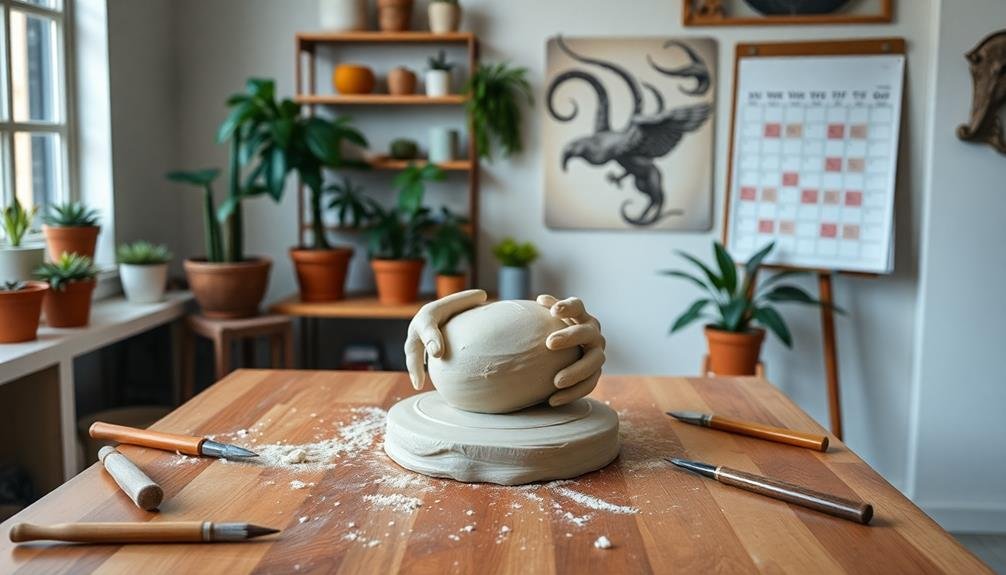
To excel in clay sculpting, establishing a consistent practice routine is essential. Set aside dedicated time each day or week for your craft, even if it's just for a short session. Consistency will help you improve your skills and maintain a connection with your creative side.
Choose a quiet, comfortable space where you can focus without interruptions. This will allow you to immerse yourself fully in the sculpting process.
As you develop your routine, consider incorporating these elements:
- Warm-up exercises: Start each session with simple clay manipulation techniques to loosen your hands and get into the creative mindset.
- Skill-building projects: Work on specific techniques or challenges to expand your abilities and push your boundaries.
- Free-form exploration: Allow time for spontaneous creation without a set goal, encouraging experimentation and discovery.
- Reflection and planning: End each session by evaluating your progress and setting goals for the next one.
Frequently Asked Questions
Can Clay Sculpting Help With Specific Anxiety Disorders Like PTSD or OCD?
Clay sculpting can potentially help with PTSD and OCD. It's a calming, tactile activity that may reduce stress and promote mindfulness. You'll focus on creating, which can distract from anxious thoughts and provide a sense of control.
Are There Any Potential Allergies or Sensitivities to Consider When Working With Clay?
You should be aware of potential allergies to clay dust or additives. If you're sensitive to metals, check for lead content. Watch for skin reactions to certain clays. Always work in a well-ventilated area to minimize risks.
How Long Should a Typical Clay Sculpting Session Last for Anxiety Relief?
You'll want to aim for 20-30 minutes initially. As you get comfortable, you can extend sessions up to an hour. Listen to your body and mind—stop when you feel relaxed or if you're getting frustrated.
Can Clay Sculpting Be Combined With Other Therapeutic Techniques for Better Results?
You can definitely combine clay sculpting with other therapeutic techniques. Try pairing it with mindfulness meditation, deep breathing exercises, or music therapy. You'll likely experience enhanced relaxation and stress relief by integrating multiple approaches into your self-care routine.
Are There Age Restrictions for Using Clay Sculpting as an Anxiety Management Tool?
You'll find clay sculpting beneficial for anxiety management at any age. There aren't strict restrictions, but you'll need to take into account safety for very young children. Adapt techniques and materials to suit different age groups and abilities.
In Summary
You've now got seven powerful tools to harness clay sculpting for anxiety relief. Remember, it's not about creating masterpieces, but finding peace in the process. As you mold and shape, you're also reshaping your thoughts and emotions. Don't be afraid to get your hands dirty and explore this tactile art form. With practice, you'll discover that sculpting isn't just about creating objects – it's about crafting a calmer, more centered version of yourself.

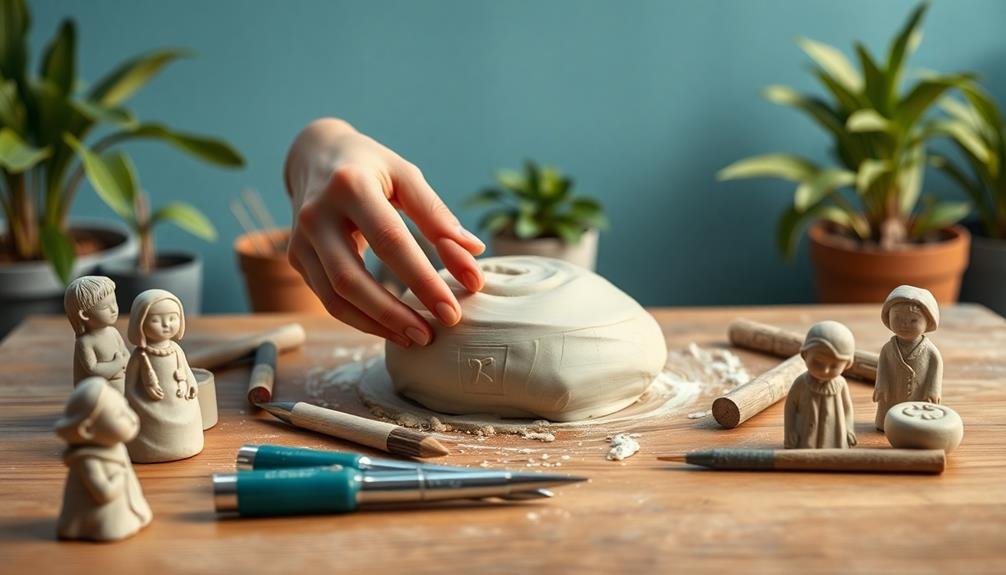

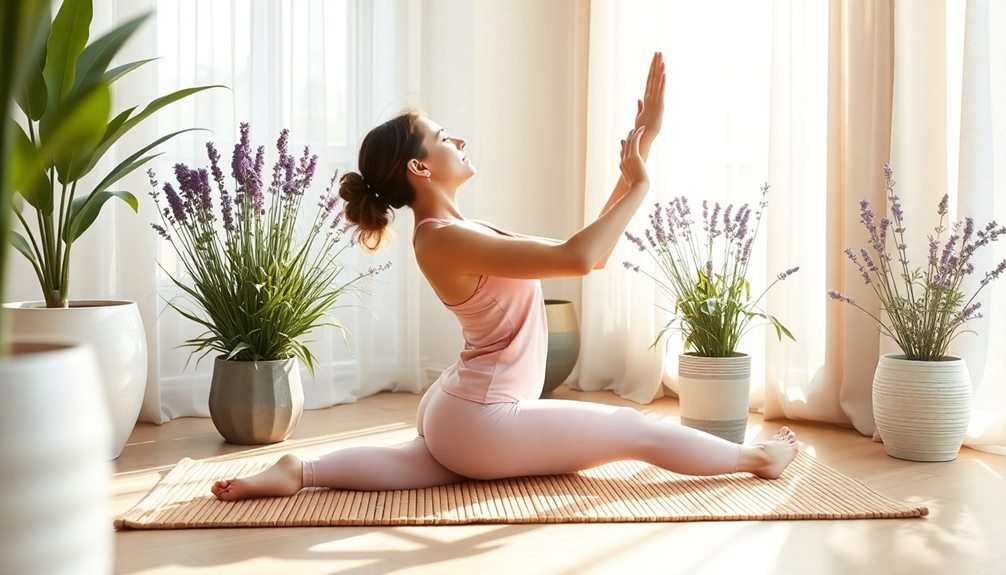
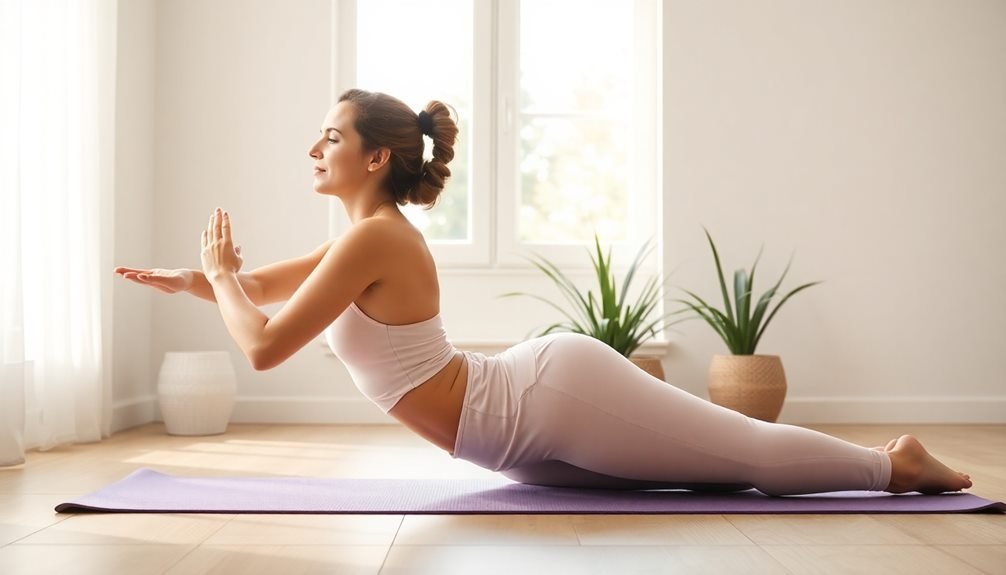
Leave a Reply